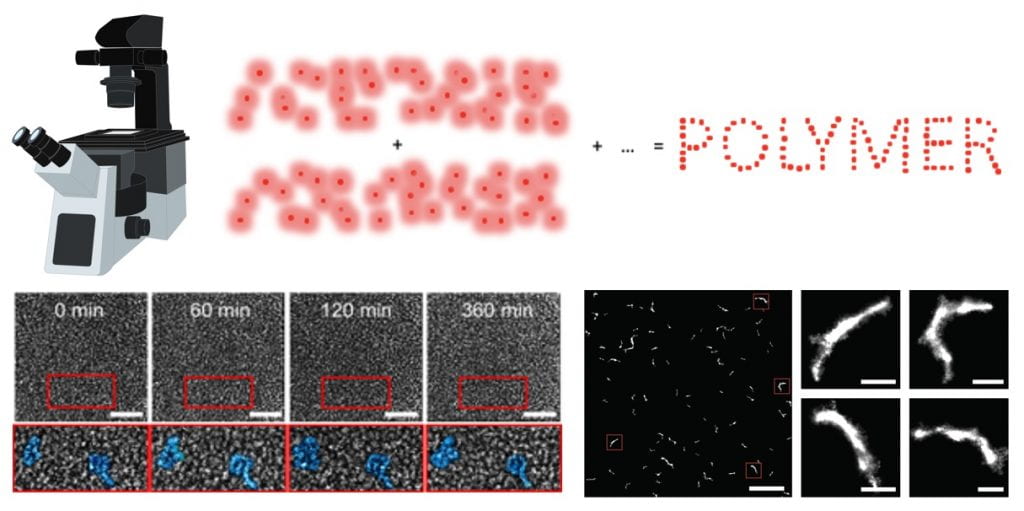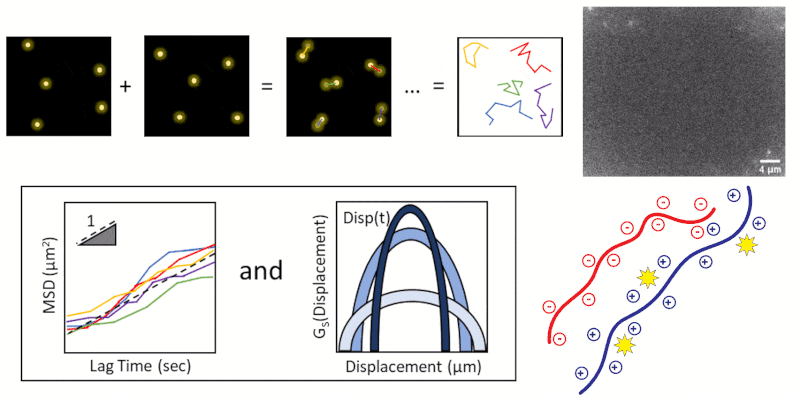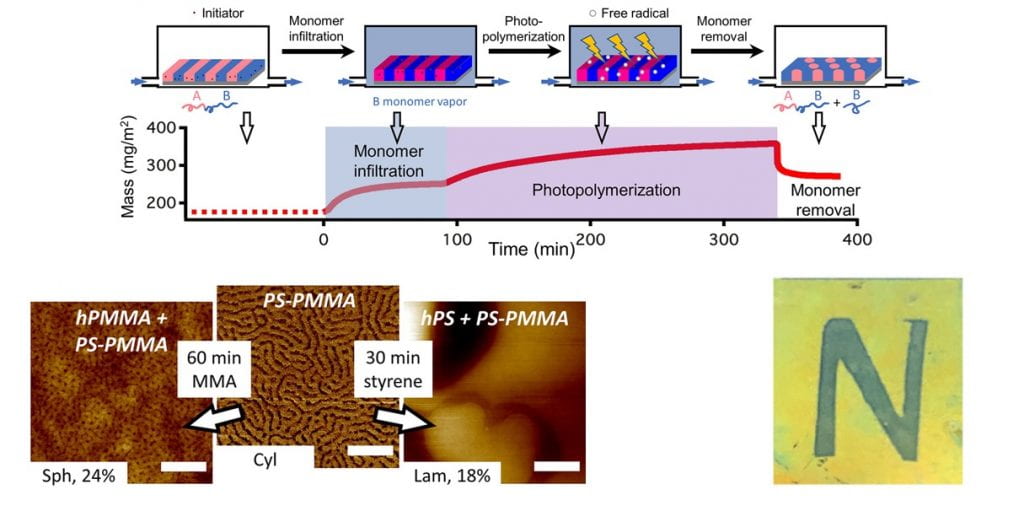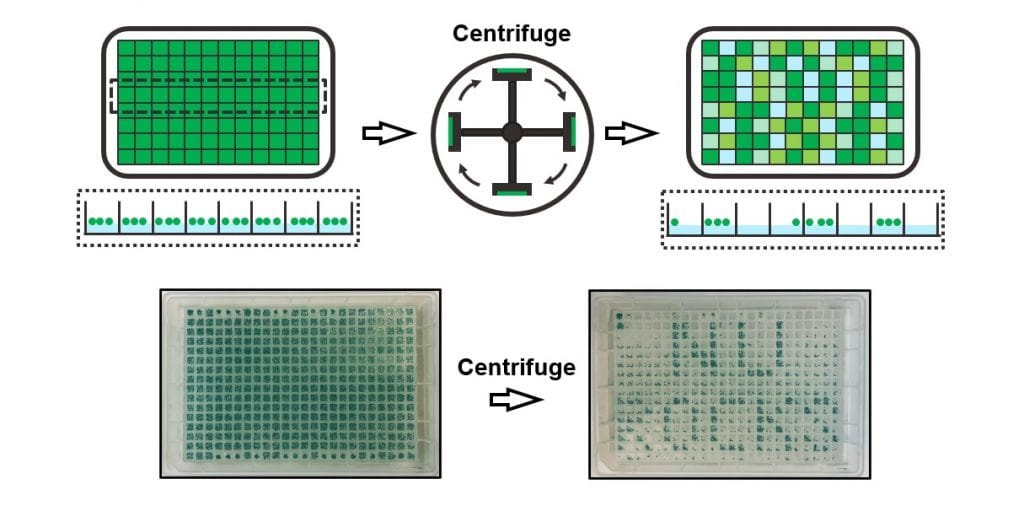Nanoscale characterization of polymers using super-resolution optical microscopy

The properties of polymer-based materials are driven by phenomena at nanoscopic length scales. We use super-resolution optical microscopy to investigate these phenomena in their native environment, at nanometer resolutions, in real time. The unprecedented knowledge accessed using these super-resolution techniques can offer insights in bridging the nanoscopic polymer chain behaviors to bulk polymer properties. Specifically, we are using these methods in bottlebrush polymers, interpenetrating polymer networks, and self-assembly by phase separation.
- Direct visualization of bottlebrush polymer conformations in the solid state. Chan JM, Kordon AC, Zhang R, Wang M.* Proceedings of the National Academy of Sciences of the USA. 2021:118:e2109534118.
- 100th Anniversary of Macromolecular Science Viewpoint: Enabling Advances in Fluorescence Microscopy Techniques. Qiang Z, Wang M.* ACS Macro Letters. 2020:9:1342-1356.
- A polymerizable photoswitchable fluorophore for super-resolution imaging of polymer self-assembly and dynamics. Qiang Z, Shebek KM, Irie M, Wang M.* ACS Macro Letters. 2018:7:1432-1437.
Exploring polymer dynamics using single-particle tracking

Single particle tracking is a powerful tool for probing the dynamics of polymer systems at the molecular level. Dynamic phenomena in polymers depend on a wide range of factors such as chain length, presence and strength of charge, and interactions with adjacent polymers and surfaces. Unlike other methods, single particle tracking allows us to directly visualize the movement of our polymers in three-dimensions at nanometer resolutions. Monitoring our sample over a series of images allows us to localize the position of each polymer over time and construct the trajectories of each individual molecule. This leads to insight into the diffusive regimes the polymer explores. We use this method to explore hydrophilic polymers, polyelectrolytes, and polymer network self-healing.
- Determination of hydrophobic polymer clustering in concentrated solutions through single particle tracking diffusion studies. Landfield H, Wang M.* Macromolecules. 2022:55:7425-7437.
Controlling nanoscale morphologies using in-film photopolymerization

In traditional approaches to self-assembly, polymers are first synthesized with control over monomer sequence, composition, and architecture, and then the molecules are fabricated into films or bulk materials. This two-step approach is limiting because the final morphology is governed by the polymer chemistry, so there is little control of the resulting nanostructures after the fact. We are developing an in-film polymerization technique, which applies free-radical polymerization to monomers swelled into self-assembled block copolymer films. As a result, we can modify the morphology in real time by altering the chemistry and composition. This method can generate hierarchical patterns, which is of particular interest in photonic crystals.
- Integration of polymer synthesis and self-assembly for controlled periodicity and photonic properties. Zhang R, Qiang Z, Wang M.* Advanced Functional Materials. 2021:31:2005819.
- Simultaneous in-film polymer synthesis and self-assembly for hierarchical nanopatterns. Qiang Z, Akolawala SA, Wang M.* ACS Macro Letters. 2018:7:566-571.
High-throughput screening of mechanical properties

The ability to simultaneously measure the properties of thousands of materials can enable large datasets for machine-learning guided materials design. We are developing high-throughput mechanical testing methods to meet this need. We have devised a simple and inexpensive high-throughput adhesion screening method for both synthetic and bio-derived materials using a centrifuge and microparticles. In the meantime, we are designing new high-throughput methods to characterize the mechanical strength of soft materials. As our characterization method potentially opens a new venue for material design using machine learning, we can expect AI-designed materials become a possibility in the future.
- High-throughput screening test for adhesion in soft materials using centrifugation. Chen Y, Wang Q, Mills CE, Kann JG, Shull KR, Tullman-Ercek D, Wang M.* ACS Central Science. 2021:7:1135–1143.
- Quantitative high-throughput measurement of bulk mechanical properties using commonly available equipment. Griffith J, Chen Y, Liu Q, Wang Q, Richards JJ, Tullman-Ercek D, Shull KR, Wang M.* Materials Horizons. 2023:10:97-106.




